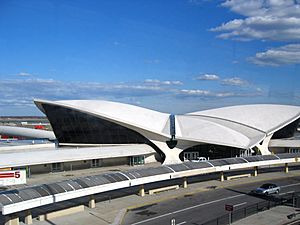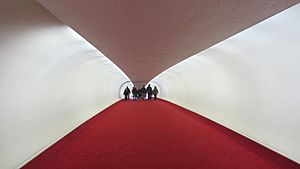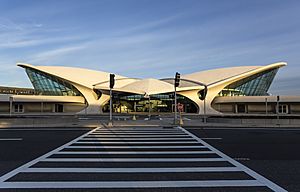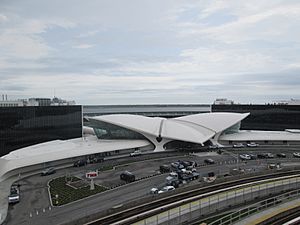TWA Flight Center facts for kids
|
Trans World Airlines Flight Center
|
|

The terminal's head house in 2010
|
|
| Location | Terminal 5, John F. Kennedy International Airport New York City, United States |
|---|---|
| Area | 17.6 acres (7.1 ha) |
| Architect | Eero Saarinen and Associates; et al. |
| Architectural style | Futurist, Neo-futurist, Googie, Fantastic |
| NRHP reference No. | 05000994 |
Quick facts for kids Significant dates |
|
| Added to NRHP | September 7, 2005 |
The TWA Flight Center, also known as the Trans World Flight Center, is an airport terminal and hotel complex at New York City's John F. Kennedy International Airport (JFK). The original terminal building, or head house, operated as a terminal from 1962 to 2002 and was adaptively repurposed in 2017 as part of the TWA Hotel. The head house is partially encircled by a replacement terminal building completed in 2008, as well as by the hotel buildings. The head house and replacement terminal collectively make up JetBlue's JFK operations and are known as Terminal 5 or T5.
The TWA Flight Center was designed for Trans World Airlines by Eero Saarinen and Associates, and was erected between 1959 and 1962. It featured a prominent wing-shaped thin shell roof supported by four "Y"-shaped piers. Inside was an open three-level space with tall windows enabling views of departing and arriving jets. Two tube-shaped red-carpeted departure-arrival corridors extended outward from the terminal, connecting to the gates. Roche-Dinkeloo, a successor firm to Saarinen's company, designed an expansion in 1970. The TWA Flight Center continued to operate as an air terminal until 2002. Its design received much critical acclaim; both the interior and the exterior of the head house were declared New York City Landmarks in 1994, and it was added to the National Register of Historic Places in 2005.
The encircling Terminal 5 addition was designed by Gensler and constructed between 2005 and 2008. It contains the 26 active gates at Terminal 5, as well as numerous restaurants and stores. Although portions of the original complex have been demolished, the head house remains standing. The Port Authority of New York and New Jersey (PANYNJ), which operates JFK Airport, had once intended the original structure as an entrance to the replacement terminal. In 2016, the Port Authority began converting the original head house into the TWA Hotel, which opened in 2019 with two additional buildings adjacent to the T5 addition.
Design
The head house of the TWA Flight Center, designed by Eero Saarinen and his associates, is a pioneering example of thin-shell construction, consisting of a reinforced concrete shell roof supported at the corners. The design incorporates elements of the Futurist, Neo-futurist, Googie and Fantastic architectural styles. It is located at the middle of a curve in one of JFK Airport's service roads, in front of the elevated AirTrain JFK people mover. The key collaborators from the Saarinen office included Kevin Roche, Cesar Pelli, Norman Pettula, and Edward Saad. Warren Platner was largely responsible for the interiors. To engineer the roof, Saarinen collaborated with Charles S. Whitney and Boyd G. Anderson of the firm Ammann & Whitney. The general contractor was Grove Shepherd Wilson & Kruge.
The Terminal 5 (also known as T5) addition, which is connected to the TWA Flight Center, is a 625,000-square-foot (58,100 m2) facility designed by Gensler. It contains 26 gates that can accommodate 250 flights per day, and 20 million passengers annually.
Form

- Original 1962 Saarinen terminal (TWA Flight Center)
- 2008 Gensler-designed terminal
The form, or layout, of the TWA Flight Center's head house is designed to relate to its small wedge-shaped site, with walkways and gates placed at acute angles. Saarinen described the head house form as being like the "Leonardo da Vinci flying machine", according to his associate Kevin Roche. Radiating out from the head house are two departure-arrival passenger tubes extending southeast and northeast.
The TWA Flight Center was one of the first to utilize enclosed passenger jetways, which extended from "gate structures" at the end of each tube. In the original plans, aircraft would be available via the "Flight Wing", a single-story building that passengers would have to walk to at ground level. The jetways removed the need for passengers to walk on the ground and sheltered passengers from inclement weather.
The current JetBlue terminal and the TWA Hotel buildings are located east of the original head house. The terminal's entry hall is composed of two arms that wrap around the TWA Flight Center's head house in a crescent shape. The two passenger tubes from the original design were retained, but the original gate structures were destroyed. T5 contains 26 gates.
Exterior
Roof
The TWA Flight Center's head house is a two-story structure. The roof's thin concrete shell is built to span a space with a minimum of material. The roof is composed of four concrete shells: two upward-slanting shells at the edges, which resemble wings, and two smaller shells slanting downward toward the front and back of the structure. The upward-slanting shells reach a height of up to 75 feet (23 m) above the ground level. The rooftop shells converge at the center of the roof, where each of the four shells supports the others. Four "Y"-shaped piers support the roof, facing the front and back facades. Skylights are located within the gaps between each shell. The building's main entrance is on the land side, where the roof projects over a sidewalk (formerly a driveway) with a scupper.
The roof concrete varies in thickness from 7 inches (180 mm) at the edges to 40 inches (1,000 mm) at the convergence of the four shells. It weighs 6,000 short tons (5,400 t) in total.
Facade
The main portion of the head house's facade is made of large green-tinted glass walls. These glass walls were coated with a dark-purple mylar film before 2005. Single-story wings extend outward from the main terminal to the north and south, and contain several door openings within the concave walls. Inside these wings are maintenance areas.
Interior
Original head house
Though the head house is two stories tall, it contains an intermediate level, joined to the lower level by a central staircase and to the upper level by four peripheral staircases. Ceramic tiles line the walls and floors. The TWA Flight Center incorporated many innovations upon its completion, including closed circuit television, a central public address system, baggage carousels, electromechanical split-flap display schedule board and baggage scales, and the satellite clustering of gates away from the main terminal. The intermediate level contains an area facing east, where passengers could originally see the tarmac. By the early 1990s, to comply with the Americans with Disabilities Act of 1990, a switchback ramp had been added between the lower level and the intermediate level.
The ticket counter and baggage claim areas were placed at ground level, on the other side of the curbside canopy, to maximize convenience for passengers. A sculpted marble information desk rose from the floor as a single slab. There are also mechanical, service, and office areas in a partial basement under the intermediate level, as well as a tunnel that led to Flight Wing 1.
A concrete balcony on the upper floor spans the central staircase from the lower floor to the intermediate level. The TWA operated its Ambassador Club on the northern (left) portion of the upper floor. Three restaurants were located on the southern (right) portion of the upper floor: the Constellation Club, Lisbon Lounge, and Paris Café. Offices were also located on the upper level, north and south of the public areas.
Terminal 5 and TWA Hotel
Terminal 5 has a 55,000-square-foot (5,100 m2) retail area with 22 food and drink concessions, 35 stores, free wireless Internet access, a children's play area, and a 1,500-space parking garage. As the first airline terminal at JFK designed after the September 11, 2001, attacks, T5 contains 20 security lanes, one of the largest checkpoints in a US airline terminal.
Two buildings, north and south of the newer T5 structure, encircle the original head house to the east. These buildings are part of the TWA Hotel, which has 512 guest rooms, 40,000 square feet (3,700 m2) feet of meeting space, and an observation deck of 10,000 square feet (930 m2). The hotel is outside the sterile area of Terminal 5, meaning that visitors can only access the hotel before going through T5 security or after arrival at T5. The hotel's decorations, replicas of the original furnishings, include brass lighting, walnut-accented furnishings, and rotary phones. The hallways contain red carpeting, evocative of the color of the furniture in the original TWA lounge. The rooms also contain modern amenities such as blackout curtains and multiple-pane soundproof windows.
Passageways
The two passageways leading from the head house are completely enclosed and cross a service roadway that serves T5 and the TWA Hotel. The passageway leading southeast was called Flight Tube 2, while the passageway leading northeast was called Flight Tube 1. These tubes are covered in concrete, with an elliptical cross section as well as indirect lighting. To save money, the passageways did not have moving walkways. The passageways originally led to Flight Wings 1 and 2, and ascended about 6 feet (1.8 m) between the head house and the respective flight wings. Flight Tube 1 was about 232 feet (71 m) long while Flight Tube 2 was 272 feet (83 m) long. Following the opening of the TWA Hotel, the tubes connect the head house to additional rooms in the hotel, as well as to T5.
Flight wings
Flight Tube 2 connected to Flight Wing 2, from the 1962 Saarinen design, while Flight Tube 1 connected to Flight Wing 1, from a 1967–1970 expansion designed by successor firm Roche-Dinkeloo. Both sections were characterized as being "violin"-shaped, with jetways extending outward from the end of each wing. The flight wings had a base made of concrete and plaster, as well as a passenger concourse cantilevered above the base.
Flight Wing 2, shaped like a multi-sided polygon, was the smaller of the two structures, with seven gates; it contained utilitarian decor as well as a small flight operation center above the passenger area. Two bridges led to departure lounges (labeled gates 39 and 42), which could both fit 100 passengers; these had a red-and-oyster color scheme with furnishings. Flight Wing 1 was much larger than Flight Wing 2, having been built to accommodate Boeing 747 jumbo jets, and had 10 gates. Flight Wing 1 contained four levels, which served passengers, Federal Inspection Services, and operations; there were also baggage claim carousels in Flight Wing 1's basement, connected to the head house via people mover. Both flight wings were demolished with the construction of T5 in the 2000s.
History
New York International Airport, also known as Idlewild Airport, began construction in 1943 on the site of the Idlewild Beach Golf Course in southern Queens, and had been operating since 1948 with a single terminal building and a control tower. The following year, Transcontinental and Western Airlines (TWA) signed a lease with the Port of New York Authority (later the Port Authority of New York and New Jersey, or PANYNJ), which operated Idlewild Airport. TWA had begun flying internationally in 1946 from New York's LaGuardia Airport with flights to Paris, London, Rome, Athens, Cairo, Lisbon, and Madrid. In 1950, as both a domestic and international carrier, the former Transcontinental and Western Airlines changed its name to Trans World Airlines. By 1954, Idlewild had the highest volume of international air traffic of any airport globally.
1955–1962: Planning, design, and construction
In 1955, the "Terminal City" master plan was developed for Idlewild Airport. All of the major airlines, including TWA, would build their own terminals, while smaller airlines would be served from an International Arrivals Building. When the locations of each airline's terminal was announced, TWA and Pan Am were each assigned a spot on one side of the International Airlines Building; TWA's hangar was on the opposite side of its assigned lot. Under the leadership of TWA president Ralph S. Damon, TWA hired Eero Saarinen and his Detroit-based firm to design the TWA Flight Center. A writer for the Interiors journal described TWA as having "vision and confidence" for the project. TWA anticipated that at peak hours, the terminal would accommodate a thousand passengers, with two thousand departures and arrivals per hour. Additionally, TWA needed fourteen positions at the terminal for large jets. Eero Saarinen's wife Aline recalled that her husband saw most other air terminals as being ugly, shoddy, and inconvenient. Saarinen wanted the new terminal to be practically useful as well as a symbol to "interpret the sensation of flying."
The Saarinen team started devising designs for the terminal's form in February 1956. Although the site assigned to TWA was not the airline's first choice for an Idlewild terminal, the design team took advantage of the site to design a highly visible terminal. Unhappy with initial designs, Saarinen asked TWA for more time and took an additional year to resolve the design. Roche said that one initial design had called for an oval shell upon four piers, but that Saarinen had rejected that plan as awkward. Furthermore, engineer Abba Tor had warned that a single slab of concrete might crack. To model the roof of the TWA terminal, Saarinen's team created several models made of wire, cardboard, and clay. Models for the interior were also created; Roche said that the model for the area around the center staircase was redone at least ten times. In addition to around 130 possible plans created by the Saarinen office for the terminal, contractors provided hundreds of their own drawings. Cross-sections and contour maps were also devised. The drawings took some 5,500 man-hours to produce.
By November 1957, TWA had announced a design with a projected cost of $12 million (equivalent to $90 million in 2021). Aline Saarinen worked with TWA to coordinate marketing activities centered on the terminal from the building announcement to its completion in 1962. The plans were revised in 1958 after Saarinen's original design was determined to be too expensive. Though both flight wings had been included in the original plan, only Flight Wing 2 was initially built as a cost-saving measure. The passageways were to have a glazed roof and moving walkways in the original plan, but these features were absent in the final construction, and two "arms" flanking the head house had been removed.
Construction began in June 1959, involving 14 engineers and 150 workers. When Eero Saarinen died unexpectedly of a brain tumor in 1961, Kevin Roche and John Dinkeloo formed Roche-Dinkeloo, which worked to complete the building. A grid was also devised to manage the steel-pipe scaffolding at the construction site, and 5,500 supports were used in the scaffolding. The contour maps were precise to intervals of 1 foot (0.30 m). Although the project employed carpenters with "no special skill", the procedures were precise enough that they allowed for a maximum deviation of only 0.25 inches (6.4 mm) from the plan. The roof was poured as a single form starting on August 31, 1960; the work took 120 hours. By the end of 1960, the roof was fully supported by the four "Y"-shaped piers, and the scaffolding was removed.
1962–2002: Original terminal
By March 1962, the incomplete TWA terminal was being used by passengers to get to planes. The unfinished terminal building was also used for a fundraising benefit that April. The completed terminal was dedicated on May 28, 1962. Most other major U.S. airlines had completed their Idlewild terminals sooner: after the opening of the International Arrivals Building in 1957, United Airlines and Eastern Air Lines opened their own terminals in 1959, followed by American Airlines and Pan American World Airways (Worldport) in 1960, and Northwest Airlines and TWA in 1962. The National Airlines Sundrome would be last, in 1969. The airport's name was changed to John F. Kennedy International Airport in 1963. Despite being finished relatively late compared to other terminals at JFK Airport, the TWA Flight Center incorporated many novel features for its time, which influenced the design of other airport terminals.
The terminal as completed had seven aircraft positions, six of which were available from Flight Wing 2; the other boarding position was available from a temporary structure attached to Flight Tube 1. As with many terminals designed before the advent of jumbo jets, increased passenger traffic and security issues, the design proved difficult to update as air travel evolved; terminal gates close to the street made centralized ticketing and security checkpoints difficult. International flights at JFK during the 1960s were routed through the International Arrivals Building, and the structure attached to Flight Tube 1 was functionally inadequate. By 1967, TWA announced that it would build Flight Wing 1 on the northwest to accommodate wide-body aircraft, hiring Roche-Dinkeloo to design the $20 million expansion. Work started in 1968, and the concrete shell was finished by that December. Flight Wing 1 opened on February 25, 1970, but the wing was not dedicated until March 20, when international passengers could pass through the terminal directly. With the addition of Flight Wing 1 came the expansion of the ticketing counter in the head house. The baggage handling area was expanded and the new addition was connected to the basement of Flight Wing 1.
By 1979, TWA had built a traffic island with a canopy to provide shelter for passengers waiting for ground transport. The shelter, constructed by firm Witthoefft & Rudolf, won the Albert S. Bard Award for architectural excellence. A wooden walkway, intended as a temporary structure, was built in the 1980s to connect to the Sundrome when TWA expanded its operations there. By 1992, the TWA Flight Center was in "tawdry condition", with parts of the structure appearing actively deteriorated. The PANYNJ considered demolishing the building, but the New York City Landmarks Preservation Commission designated it as an exterior and interior landmark in 1994, ensuring its preservation. Instead, the PANYNJ started considering plans for what would become the T5 expansion. Elastomeric coating was added to the roof in 1999 to prevent leakage.
TWA deteriorated financially during the 1990s, and after it eliminated many routes in 1996, moved most of its New York operations to the TWA Flight Center. TWA eventually sold its assets to American Airlines in October 2001. For three months, American Airlines still operated flights out of the TWA Flight Center. The terminal was officially closed in January 2002 with the expiration of the lease that had been held by TWA. By then, airport officials saw the terminal as functionally outdated.
2001–2005: Preservation attempts
As a bi-state agency, the PANYNJ could legally bypass the Landmarks Preservation Commission's designation and demolish parts of the terminal. However, after preservationists raised concerns, the PANYNJ proposed an alternative that would preserve the tubes and build a new structure east of the existing building. The PANYNJ still wished to destroy one or both of the flight wings. By August 2001, the PANYNJ presented its first proposal, which entailed converting the head house into a restaurant or conference center, while encircling the existing building with one or possibly two new terminals. The concept received opposition from the Municipal Art Society (MAS), as well as architects Philip Johnson and Robert A.M. Stern. The opposition suggested the building, which brought passengers into immediate view of the sky and aircraft beyond, would be "strangled" if wrapped by another terminal, and that wrapping the Saarinen head house with another terminal would not preserve the spirit of the building but would mummify it "like flies in amber." Philip Johnson, speaking at the 2001 presentation, said of the proposal:
This building represents a new idea in 20th-century architecture, and yet we are willing to strangle it by enclosing it within another building. Imagine, tying a bird's wings up. This will make the building invisible. If you're going to strangle a building to death, you might as well tear it down.
By late 2002, there was still no agreement on the usage of the TWA Flight Center, except that the head house and passageways would be preserved. The following year, the PANYNJ and JetBlue agreed on a plan that would include reopening the TWA Flight Center and constructing a new 26-gate Terminal 5 behind the TWA Flight Center. At the time, JetBlue was operating out of the adjacent Terminal 6, the Sundrome, and was the airport's fastest growing carrier. The PANYNJ and JetBlue came to an agreement on the construction of the new terminal itself in August 2004.
In the time that the TWA Flight Center stood disused, it was utilized for brief events. Shortly after its closure, the head house was used for the filming of the 2002 film Catch Me If You Can. In 2004, the dormant head house briefly hosted an art exhibition called Terminal 5, featuring the work of 19 artists from 10 countries. The theme of the show featured work, lectures and temporary installations drawing inspiration from the terminal's architecture—and was to run from October 1, 2004 to January 31, 2005—though it closed abruptly after the building itself was vandalized during its opening gala. The building was added to the National Register of Historic Places in 2005.
2005–present: new JetBlue terminal
In December 2005, the PANYNJ began construction of the T5 facility behind and partially encircling Saarinen's head house. Peripheral portions of the head house were demolished to make space for a larger 26-gate facility designed by Gensler. Originally, there were also tentative plans to renovate one of the departure lounges, known as The Trumpet. During the construction of T5, The Trumpet was lifted and moved 1,500 ft (460 m) at a cost of $895,000, only to be later demolished when the project's budget prioritized renovating the head house. The head house was renovated to remove asbestos and replace deteriorated sections of the facility. The head house was planned to be used as an approach to the new T5 facility, and both buildings would be collectively known as Terminal 5.
T5 reopened on October 22, 2008, with JetBlue using an abstraction of the Saarinen terminal's gull-wing shape as the official logo for the event, an abstraction of the new terminal floor plan for the signage and counting down the reopening via Twitter. At the time of the T5 opening, JetBlue and PANYNJ had yet to complete renovation of the original Saarinen head house, and the building had stood empty while they decided what its future role should be. Early proposals included a conference center, an aviation museum, and a restaurant, or a place to check in for flights departing from the newer JetBlue T5 building.
2016–2019: Conversion of head house into hotel
In April 2015, The Wall Street Journal reported that JetBlue and its partner, a hotel developer, were negotiating for the rights to turn the head house into a hotel. Three months later, state governor Andrew Cuomo confirmed that the Saarinen building would become part of the TWA Hotel, a new on-site hotel for airport passengers. Construction began in December 2016. The structures on either side of the head house were demolished, though the head house was retained, and additional structures were built. During the head house's conversion into a hotel, many original details, such as the custom ceramic floor tiles and the 486 variously-shaped window panels, were replaced with replicas of the originals. The departure board from the original construction was also restored. The hotel opened on May 15, 2019.
See also
 In Spanish: TWA Flight Center para niños
In Spanish: TWA Flight Center para niños











